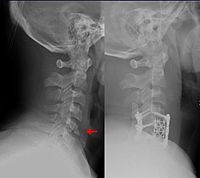
Photo from wikipedia
BACKGROUND Trabecular metal (TM)-backed glenoid implants were introduced for their theoretical ability to increase osseointegration while minimizing wear and the risk of loosening in total shoulder arthroplasty (TSA). Initial follow-up… Click to show full abstract
BACKGROUND Trabecular metal (TM)-backed glenoid implants were introduced for their theoretical ability to increase osseointegration while minimizing wear and the risk of loosening in total shoulder arthroplasty (TSA). Initial follow-up studies of TM-backed glenoids demonstrated high rates of metallic debris formation around the implant site, raising concerns about longevity. More recent data suggests that metallic debris formation may be less prevalent than previously reported and that the implants may have positive long-term outcomes regardless of debris. The goal of our study was to assess clinical and radiographic outcomes at midterm follow-up of TSA using a TM-backed glenoid implant placed with full backside support using an inset technique. We hypothesized that our clinical and radiographic outcomes would be good using this technique. METHODS After institutional review board approval (STUDY00002882), we retrospectively reviewed the charts of 39 patients who underwent 41 total shoulder arthroplasty procedures with a Zimmer TM-backed glenoid component (Zimmer Biomet, Warsaw, IN, USA) by a single surgeon between January 2010 and March 2016. After exclusions for death unrelated to surgery or loss to follow-up, 35 patients (37 shoulders) with minimum 2 year clinical follow-up were included in the study. Glenoids were all placed in an inset fashion with complete backside support. Clinical, patient-reported, and radiographic outcomes were analyzed. RESULTS Average follow-up was 7.2 years (range, 2-11 years). At final follow-up, the average shoulder elevation was 153 ± 22° and external rotation was 53 ± 12°. Average ASES scores were 86.8 ± 19.0, and VAS scores were 1.3 ± 2.4. Nine shoulders (27%) had metallic debris, and 13 shoulders (39%) had radiolucency around the glenoid components on their final postoperative X-ray. Metallic debris and radiolucency findings were low in severity with an average grade of 0.32 (± 0.54) and 0.39 (± 0.50), respectively. There were no re-operations. CONCLUSION This study of 37 shoulders undergoing TSA with a TM-backed glenoid demonstrated 100% implant survivorship at average follow-up of 7 years. Clinical outcomes were excellent despite occurrence of some metallic debris formation. The findings suggest that a TM-backed glenoid component implanted in an inset fashion to achieve full backside support can provide good clinical and patient- reported outcomes in TSA at mid-term follow-up and that continued consideration of the role for TM-backed glenoids and the optimal technique for implantation may be warranted.
Journal Title: Journal of shoulder and elbow surgery
Year Published: 2021
Link to full text (if available)
Share on Social Media: Sign Up to like & get
recommendations!